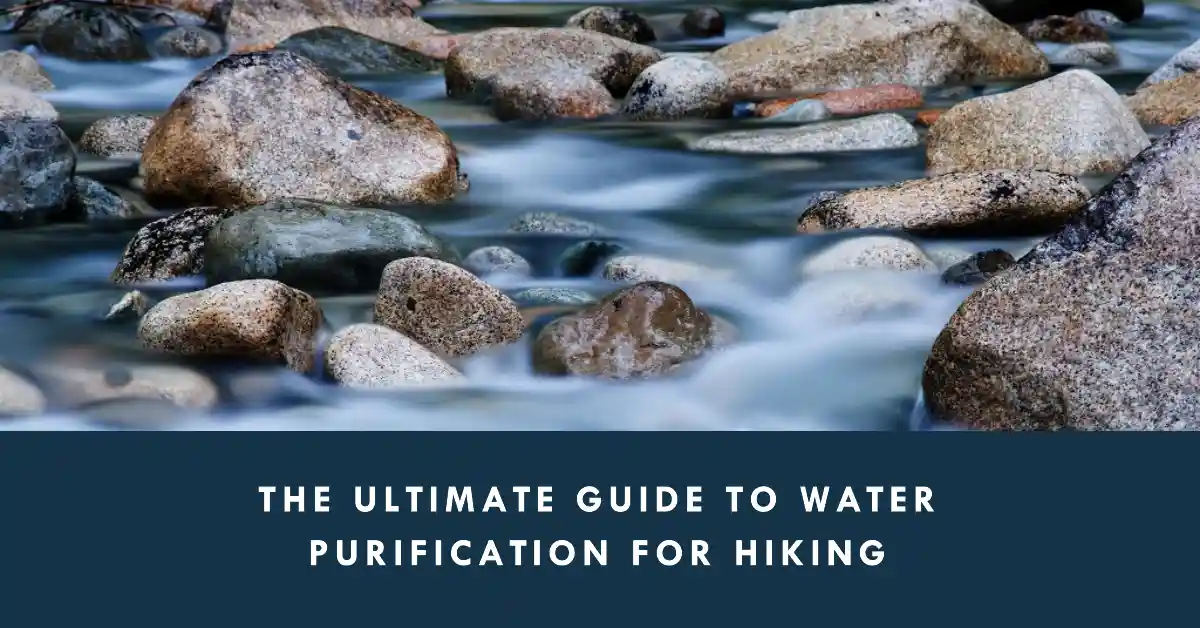Table of Contents
Some links on posts are affiliate links and will earn us a commission from qualifying purchases
Hiking is an excellent way to explore nature and challenge oneself physically. It’s an activity enjoyed by people of all ages and backgrounds.
Hikers often venture into remote areas, such as mountains or forests, where reliable sources of clean water may not be readily available. Water is undoubtedly one of the most important elements a hiker needs to survive while on the trail.
However, without learning about different methods of purifying water, drinking contaminated water can lead to several health complications that can ruin an otherwise fantastic trip.
Importance of Purifying Water While Hiking
When you are hiking in a remote location, accessing clean drinking water is crucial for your survival. Drinking contaminated water poses a significant risk to your health, which could result in mild stomach upsets or severe illnesses such as Giardia or Cryptosporidium infections.
These diseases are caused by bacteria and viruses found in untreated water sources such as rivers or streams that can lead to dehydration, vomiting and diarrhea- all detrimental conditions when you’re trying to conquer rough terrain.
The human body cannot function without access to clean drinking water – especially during physical activities like hiking when one loses valuable fluids through sweating and exertion.
Carrying enough purified drinking water for long trips is not practical due to weight limitations; thus it’s vital for hikers always to have access to natural sources of potable water along the trail.
Understanding Water Contaminants
Waterborne illnesses are a serious risk for hikers who drink untreated water. Understanding the different contaminants in water can help hikers select the best method of purification for their needs. There are four main types of contaminants: physical, chemical, biological, and radiological.
Types of Water Contaminants
Physical contaminants include sediment, debris, and organic matter that can make water appear cloudy or discolored. Chemical contaminants come from agricultural and industrial runoff and include pesticides, herbicides, and heavy metals such as lead and mercury.
Biological contaminants include bacteria (such as E. coli), viruses (such as hepatitis A), protozoa (such as Giardia), and parasites (such as tapeworms). Radiological contaminants can occur naturally or be man-made and include uranium, radium, cesium-137.
Health Risks Associated with Contaminated Water
Contaminated water can cause a range of health problems from mild to severe. Some symptoms may occur within hours of drinking contaminated water while others may take days or weeks to develop. Common symptoms of waterborne illness include diarrhea, vomiting, stomach cramps, fever, headache, muscle aches.
In some cases, untreated water can lead to more serious illnesses such as cholera or typhoid fever that require medical attention. Certain groups such as children under 5 years old or people with weakened immune systems are particularly vulnerable to these illnesses.
Sources of Water Contamination
Water sources that look clean may still be contaminated by human or animal waste products in the surrounding area. Human activity such as camping near a stream or leaving waste behind can also contribute to increased contamination levels in surrounding bodies of water.
Other sources of contamination could be natural occurrences in the environment including weather events like flooding which could push sediment, debris, and bacteria into water sources. Additionally, industrial runoffs and agricultural practices could contribute to chemical contamination in water sources.
It’s important for hikers to understand the various types of contaminants that can be found in natural water sources so they can choose the right purification method for their needs.
Purifying Water Methods
Purifying Water by Boiling
Boiling water is one of the most effective ways to purify it from contaminants. It can kill bacteria, viruses, and parasites by raising the temperature of water beyond their survival point.
To properly boil water, bring it to a rolling boil for at least one minute at sea level or for three minutes if you’re above 6,562 feet (2000 meters). Boiling requires no special equipment but may take longer in high altitudes.
Boiling water is relatively inexpensive but requires a heat source.
Check out our beginner’s guide to camping stoves.
Purifying Water by Chemical Treatment
Chemical treatment involves adding a chemical solution to your water source to kill harmful microorganisms. The most common types of chemical treatments are iodine and chlorine tablets or drops.
These treatments can effectively remove bacteria and viruses from your water source. However, they cannot remove some types of parasites that can live in your digestive system even after you ingest them.
They’re lightweight and compact but may leave an unpleasant taste in the water.
Purifying Water by Filtration
Filtration is another popular method for purifying your hiking water sources from harmful contaminants such as bacteria, protozoa, and larger particulate matter. Filtration systems work by straining water through tiny pores that trap the contaminants while allowing clean drinking water to pass through.
There are various types of filters including pump filters, gravity filters, and bottle filters which all vary in effectiveness and price range.
Some models require pumping while others use gravity to filter the water. They’re moderately priced but can be heavy or bulky.
Purifying Water by UV Light Treatment
UV Light treatment uses ultraviolet light rays to destroy any micro-organisms present in the water source such as bacteria and viruses. It’s a quick-acting method that has become increasingly popular due to its compact size and lightweight nature making it easy for hikers to carry with them on their hikes.
UV light treatment works by exposing microbes in the contaminated water source directly to UV-C radiation which inhibits their ability to replicate thereby making them harmless.
These devices are lightweight but require batteries or a power source.
While each method has its advantages and disadvantages depending on the situation or individual needs, it’s essential to choose a method that suits your specific needs while hiking. It’s also worth noting that combining two or more methods is the most effective way to improve your chances of having clean and safe drinking water while hiking.
Choosing a Water Purification System
When it comes to choosing a water purification system for your hiking trip, there are several factors to consider. First and foremost, you should consider the effectiveness of the system in removing contaminants from the water. Look for systems that are capable of removing bacteria, viruses, and protozoa, as these pose the greatest risks to human health.
Another important factor to consider is cost. Some water purification systems can be quite expensive, so it’s important to find one that fits within your budget. Keep in mind, however, that a higher price tag may also indicate higher quality or additional features.
Convenience is also an important consideration. Some purification methods require more time and effort than others. For example, while boiling is an effective way to purify water, it can be time-consuming and requires fuel or a heat source.
Factors to Consider When Choosing a System
In addition to effectiveness, cost, and convenience, there are several other factors you should take into account when choosing a water purification system for hiking:
- Type of Hike: the length and location of your hike will influence your system selection; longer hikes or remote locations may require more robust options.
- Capacity: consider how much water you will need per day based on activity level and calculate what capacity would be necessary for filtering/purifying all required amounts at once.
- Durability: rugged terrain can be tough on gear; choose something durable enough for rough treatment along the trail.
- Maintenance: proper maintenance will extend the life of your equipment; choose something easy to maintain while on-the-go.
Best Practices for Water Purification while Hiking
Pre-hike preparation
Before heading out on a hike, it is important to plan ahead for water purification. This includes researching the area you will be hiking in to identify potential water sources and understanding the types of contaminants commonly found in that area.
It is also important to bring an adequate amount of water and a reliable purification system. Additionally, familiarize yourself with the instructions for your chosen purification method and practice using it before your trip.
Proper use and maintenance of purification system
To ensure that your water purification system works effectively, it is critical to use it correctly. Follow the manufacturer’s instructions carefully and keep spare parts on hand in case of damage or malfunction. Be sure to clean and maintain your system regularly, as this will help prolong its life span and ensure its effectiveness.
Tips for finding clean water sources during the hike
During a hike, finding safe drinking water can be a challenge. One way to locate clean water sources is by looking for fast-moving streams or creeks that are less likely to have stagnant pools where contaminants can accumulate.
Additionally, pay attention to signs of animal activity near bodies of water; if there are no signs of wildlife near a stream or pond, it may not be safe to drink from. A useful tool for identifying potential water sources can also be found through online hiking forums or guidebooks.
Conclusion
Ensuring that you have access to safe drinking water during a hike is crucial for maintaining good health and avoiding potentially serious illnesses caused by contaminated water.
Understanding different types of contaminants as well as various methods used in purifying them is essential before embarking on an outdoor adventure. Through careful preparation before heading out on a hike, including choosing appropriate gear like backpacks with room for water bottles, and properly using and maintaining your purification system during the hike, you can reduce the risks of illness caused by contaminated water.
Remember to plan ahead, be vigilant in identifying clean water sources while on the hike, and always take precautions to ensure your safety and health. With these best practices in place, you can enjoy a safe and successful hiking trip every time.
Recent Posts
Quenching Your Thirst: Effective Water Storage Tips for Hiking
Hiking is an awesome way to explore the great outdoors, challenge yourself both physically and mentally, and connect with nature. But remember to stay properly hydrated during your hike. Our bodies...
I always advocate having water to hand when walking, and whilst I probably don't drink enough water day to day, if I am going on a long walk I will always have at least one bottle with me. I also...


